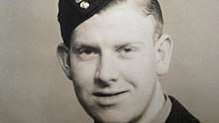Frederick Tees
Frederick "Freddie" Tees (16 June 1922 – 15 March 1982)[1] was a member of No. 617 Squadron of the Royal Air Force and who took part in Operation Chastise, the "Dambusters" raid of 1943, as a rear gunner. The raid was the inspiration for the 1955 film The Dam Busters. He ended his days as a barber in Letchworth.
Frederick Tees | |
|---|---|
 Sergeant Frederick Tees c.1943 | |
| Nickname(s) | Freddie Frank |
| Born | 16 June 1922 Chichester, England |
| Died | 12 March 1982 (aged 59) Letchworth, England |
| Allegiance | United Kingdom |
| Service/ | Royal Air Force |
| Years of service | 1941–1946 |
| Rank | Flight Sergeant |
| Service number | 1332270 |
| Unit | No. 617 Squadron RAF |
| Battles/wars | Second World War |
| Other work | Barber |
Early life
"Freddie" Tees was born in Chichester on 16 June 1922, the son of Henry Tees (1878–1944) and Elizabeth Gertrude Ayling (1885–1944).[2]
Second World War
%2C_Royal_Air_Force%2C_Scampton%2C_Lincolnshire%2C_27_May_1943_TR1000.jpg)
During the Second World War, Tees joined the Royal Air Force in 1941 with the service number 1332270. Tees was posted to No. 207 Squadron on 12 November 1942,[3] before transferring to No. 617 Squadron on 6 April 1943.[4] This squadron was created specifically to attack the Möhne and Edersee Dams using a specially developed "bouncing bomb" invented and developed by Barnes Wallis.
Tees took part in Operation Chastise, the famous "Dam Busters" raid on 16–17 May 1943. Sergeant Tees, who was 20 years old at the time of the raid, was the rear gunner in Lancaster AJ-C, piloted by Pilot Officer Warner Ottley, in the third and final wave of aircraft from No. 617 Squadron to leave from RAF Scampton. AJ-C never made it to its target and was shot down near Hamm. Tees should have been the front gunner but had changed places with Sergeant Harry Strange in the rear turret. Tees later recalled that as the aircraft began to rapidly descend, Pilot Officer Ottley said over the intercom "I'm sorry boys, they got us".[5] The aircraft then crashed.
Tees managed to escape from the rear turret and was taken prisoner of war. He was the sole survivor from the crew of seven and received serious burns. He required extensive treatment and was imprisoned at POW Camp L6 at Heydekruge until the end of the war.[4][6][7]
Later life
Later in life Tees lived at 12 Wilbury Hills Road Caravan Site and ran a gentlemen's barber shop in Station Road in Letchworth, Hertfordshire. He committed suicide on 15 March 1982.[8]
References
- Probate Record for Frederick Tees (1982) – Ancestry.com – pay to view
- England & Wales, Birth Index, 1916–2005 for Frederick Tees – Ancestry.com – pay to view
- 207 Squadron Royal Air Force History
- Tees' Profile on Dambusters.org.uk
- 'The Third Wave' – The Dambusters website
- Tees on the Royal Air Force Benevolent Fund website
- Tees on 'The Dambusters (617 Squadron)' website
- England & Wales, Death Index, 1916–2007 for Frederick Tees – Ancestry.com – pay to view